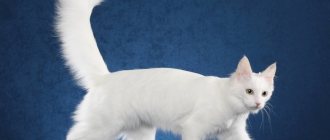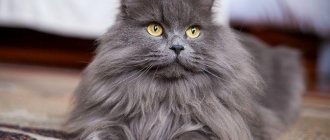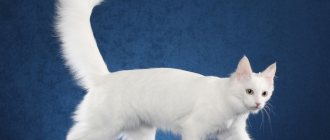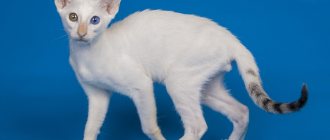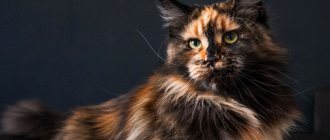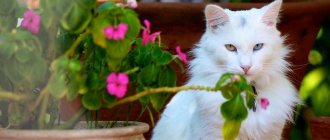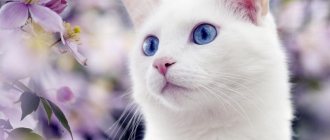History of the Turkish Angora breed
Felinologists have never been able to find out exactly when and how this breed arose - Angora cats lived next to humans for many centuries.
Presumably their ancestor was the Caucasian forest cat, who lived in the Middle Ages in Turkey. The breed appeared and developed on the territory of this state, receiving its name in honor of the city of Ankara, which has been the capital since 1923. For the first time, wayward furry pets were mentioned in local legends of the 15th century. Only noble people could afford to keep white cats with bicolor eyes, although other colors were also natural. It was believed that the person who would be bitten by such an animal should become the ruler of Turkey. Another legend explaining the veneration of Angora cats says that one of the national saints had eyes of different colors. Interesting fact: modern Turkish Angoras do not look the same as their “great-grandparents”: over a long time they have undergone changes, but they have retained their extraordinary coat, grace and sophistication.
The Turkish Angora appeared in Europe at the beginning of the 17th century thanks to an Italian aristocrat. Traveling through Turkey, Persia and India, he became interested in unusual white cats with long fur. The Italian took a couple of fluffy beauties with him.
The Turkish Angora immediately became very popular, especially at the French court. It is known that one of the first owners of the Angora cat in Europe was none other than the almighty Cardinal de Richelieu. Later, equally famous Frenchmen chose pets of this breed: Louis XIV, Marie Antoinette, Victor Hugo, Théophile Gautier. The Angora cat was the favorite of the Russian Empress Catherine the Great. However, despite its popularity, no one was engaged in its systematic selection.
At the beginning of the 19th century, the breed came to the United States, but quickly became auxiliary, serving for the breeding of Persian cats. At home in 1917-1930. The Turkish Angora has been recognized as a national treasure. The government has established a program to restore the endangered breed at the Ankara Zoo nursery. The lack of systematic selection forced European and American breeders to begin rebuilding the population in the 1950s.
Officially, the Turkish Angora was recognized only in 1973 by the CFA Association (USA). Initially, only white cats were considered to meet the standard, but by 1978 it was possible to prove the traditionality of other colors. Today the breed has champion status in all world felinological organizations. To preserve the gene pool, since 1996, the Turkish government has closed the export of white Angoras from the country, but has left the possibility of exporting cats of other colors that are considered of equal value. Interestingly, in Turkey, snow-white Angora cats with multi-colored eyes are allowed into mosques.
How many years do Angora cats live?
The lifespan of the Turkish Angora is similar to most other representatives of domestic cats - on average 14-15 years . Providing good care and adequate nutrition, as well as sufficient physical activity, can increase the average life expectancy of an Angora cat to twenty years. Negative factors that negatively affect such important indicators are some of the most common breed diseases, represented by:
- hypertrophic cardiomyopathy - a disease of the cardiovascular system;
- congenital deafness, observed in albino cats.
This is interesting! Despite the fact that very complex pathologies in the Turkish Angora are quite rare, treatment of a sick animal, due to certain characteristics of the body, requires the mandatory intervention of a professional veterinarian.
A serious disease such as ataxia, which causes serious impairment of motor coordination, is also unique to the Angora cat.
Appearance of Turkish Angora
The Turkish Angora is an elegant medium-sized cat. The flexible, elongated body is quite muscular and graceful. Females weigh 2.5-3.5 kg, males can be 2 times larger. When assessing, experts pay more attention to the balance of the physique than to the size of the animal.
Head
A flat skull and high cheekbones form a wedge-shaped head with a smooth silhouette. The forehead gently turns into a straight nose. The rounded chin in profile is perpendicular to the nose.
Eyes
Large, set wide, have a rounded, slightly oblique shape. Usually blue, green or yellow in color, individuals with differently colored eyes are often found.
Ears
Large, high-set ears have a wide base and are positioned vertically. There is a thick “brush” of fur inside, with small tassels at the ends.
Neck
The pronounced graceful neck of the Turkish Angora is of medium length.
Body
Small, fit and slender. The croup is slightly higher than the shoulders.
Legs
Slender and tall. The hind limbs are slightly longer than the forelimbs. It is desirable that there are characteristic tufts of fur between the toes.
Tail
Fluffy, almost as long as the body, tapering to a wedge-shaped tip.
Wool
The semi-long coat of the Turkish Angora is very soft, crumbly, with practically no undercoat. In the area of the “pants” and collar, the hair is slightly longer than on the rest of the body.
Color
Until today, snow-white Angora cats are in favor, but cream, brown, tabby, smoky, and red colors are also considered acceptable.
Color variations
Angora White
Completely white, eyes blue, orange, or one blue, the other orange. If the eyes are blue, the cat is more likely to be deaf.
Angora black
Completely black. Eyes are orange, brown or green.
Angora blue
The wool is gray-blue. Eyes are orange, brown or green.
Angora smoky
The coat is gray with black tips. Eyes orange, brown or green
Angora red striped
Red with intense red stripes. Eyes orange
Angora calico (harlequin)
White with black and red spots. D Eyes orange, brown or green
Angora bicolor
Wool of two shades - white with black, blue, red, cream. Eyes orange
Character of the Turkish Angora
The Angora cat has an independent, wayward character. Usually the pet behaves calmly, but sometimes it likes to run around, knocking over everything in its path, so it is advisable to provide sufficient space for games. The cat loves mouse toys, although she will not refuse live ones. If you take away an object of fun from her during a game, she will not calm down until she takes it away or demands it back. The Turkish Angora is very persistent and purposeful. He passionately loves walks and enjoys climbing somewhere higher. This cat does not like to sit on its lap for a long time, but strives to capture the attention of those around it, while never meowing loudly or making a row, but “talks” using uterine purring sounds. The Turkish Angora gets along well with pets and family members, but considers only one person to be its owner.
Cats of this breed have a developed hunting instinct, so they happily master various toys and set up ambushes. If the owner accustoms the kitten to water procedures, the adult pet will insist on bathing. Turkish Angoras have developed intelligence, easily opening bags, cabinets, and doors if desired. Animals can also learn to fetch objects and turn lights on and off. Your pet will safely hide her own toys from prying eyes. The cat suffers without human attention, but is always ready to support its sick owner.
The Angora treats strangers with caution and takes a long time to get used to new faces. The pet is obedient, easily accustomed to the scratching post, tray and rules of behavior in the house. If for some reason an animal is offended by its owner, it will deliberately violate the established order as revenge.
What affects life expectancy
The average lifespan of an Angora cat is influenced by a sufficient number of factors, ranging from breed characteristics to the conditions created for the pet’s living. The most significant factors include:
- quality food characteristics. The food used to feed the Turkish Angora must be consistently complete, varied and of high quality, which will allow maintaining the correct metabolic balance in the animal’s body, and also ensure the vital functions of the pet’s body;
- regular veterinary examinations, as well as a full range of basic timely preventive measures, including vaccination and deworming. The animal must be vaccinated against a number of the most dangerous and common diseases, including calcivirosis, rhinotracheitis and panleukopenia, rabies and infectious peritonitis, as well as trichophytosis and microsporia;
- adequate physical exercise, allowing the animal to maintain shape and remain healthy for many years. It is the passive lifestyle of a pet that most often has a very negative impact on its health.
Important! It is necessary to very carefully select pairs for mating and discard the weakest individuals. As practice shows, not only negative genes, but also the good health of an Angora cat can be inherited.
Of no small importance are the characteristics of heredity, as well as the presence in the pet’s history of a genetic predisposition to the most serious diseases. A serious attitude to the process of breeding purebred pets allows you to minimize the risk of giving birth to sick or weakened animals.
Care and maintenance
Turkish Angoras require minimal grooming. A healthy animal has a silky coat that does not tangle, so it is enough to brush it 2 times a week. White cats are bathed once every 2-3 months, using special conditioners that prevent yellowing of the coat. Pets of other colors can be washed even less often. It is necessary to regularly examine the ears and eyes of the Angora, and if necessary, wipe the shells with special lotions. Once a week you need to brush your teeth using special pastes, wipe your ears and eyes. This will avoid inflammation and the formation of tartar.
Take care of the animal's leisure time so that your pet does not spoil the furniture: buy a multi-level “cat tree”, a scratching post, and a set of toys. Get a house for your cat - personal space will become a reliable shelter for the Angora, allowing her to hide her favorite toys and just relax. If you have trained your pet to use a scratching post, there is no need to trim its nails.
This breed does not have any special dietary preferences. The most important criteria are a balanced diet and its sufficient vitamin content. Kittens should be fed 4-5 times a day, accustoming them to fermented milk products. Otherwise, you will have to buy calcium supplements to ensure normal mineralization of tooth enamel and nail growth. Adult animals need to be fed 2 times a day at strictly defined times. During the shedding period, increase your intake of fat-soluble vitamins - this will help reduce hair loss. A natural diet should include:
- fermented milk products (but not milk);
- boiled or frozen meat, offal, fish;
- raw or boiled eggs;
- vegetables.
It is not recommended to feed white Angora cats hearts, liver, seaweed - all this contributes to yellowing of the fur. This restriction does not apply to other colors. Completely protect your pet from consuming fried, peppered, too salty foods, and sweets. When choosing ready-made food, give preference to the highest quality products for long-haired cats.
Caring for Angoras
The main procedures boil down to caring for the luxurious fur of these beauties. It needs to be combed out with a brush and comb at least twice a month, but when shedding, this needs to be done more often. However, caring for your pet's delicate fur is usually not difficult.
Owners of Angora cats need to monitor the condition of the oral cavity in order to prevent plaque from forming on the teeth. However, in general, the health of these animals is excellent; no special abnormalities, other than deafness, were found.
Health and Diseases of the Turkish Angora
The Turkish Angora has good health, allowing the pet to live up to 15-20 years with proper care. Adults may suffer from congenital diseases and tartar. Kittens are susceptible to ataxia and other ailments, so constant monitoring by a veterinarian is important for up to six months. Old cats sometimes suffer from cardiomyopathy and suffer from neoplastic tumors.
White individuals with blue eyes are often born deaf, although this does not change their character. It is better to completely transfer such animals to home care and walk them on a harness. In bicolor cats, deafness may affect only one ear (the side of the blue eye).
How long do cats live on average?
Of course, a domestic cat, regardless of breed, can live noticeably longer than street, homeless individuals . If the average lifespan of a stray cat is, as a rule, no more than five to six years, then a well-groomed pet may well live several times longer, or approximately 13-17 years.
Some representatives of the cat family are able to live even up to the age of twenty. But such deadlines are more likely to be the exception to the rule than the rule.
This is interesting! As the practice of veterinary observations and keeping of the Turkish Angora shows, the average life expectancy of a sterilized or neutered pet increases by about three to four years.
It should be noted that by approximately the age of seven to eight months, cats and female cats become fully formed and sexually mature, and therefore can be used for breeding.
However, a cat's pregnancy is accompanied by characteristic hormonal abrupt changes, which is a noticeable stressful situation for the animal's body. Pets that do not give birth, but are not sterilized, are at a very high risk of developing various cancers.
How to choose a kitten
If you want to buy a healthy kitten that truly belongs to the Angora breed, contact only specialized nurseries. Be sure to look at the parents' pedigree. Buyers line up for snow-white kittens several months before the birth of the next litter. If you want to get a furry friend sooner, pay attention to Turkish Angoras of other colors. The kitten must stand confidently on its feet and be accustomed to food. Healthy animals are playful, although cautious, and do not have kinks on the tail or areas of matted fur.
